Adaptive brightness in fitness watches automatically adjusts screen intensity based on surrounding light, ensuring you’ll always see critical performance data like heart rate, pace, and distance during workouts. This technology reduces eye strain while extending battery life by 30-40%, giving you 3-5 days of usage instead of 1-2 days with fixed brightness. You’ll maintain clear visibility whether you’re training indoors, outdoors, or in changing conditions. Discover how this feature transforms your entire fitness experience.
How Adaptive Brightness Enhances Workout Performance and Data Visibility
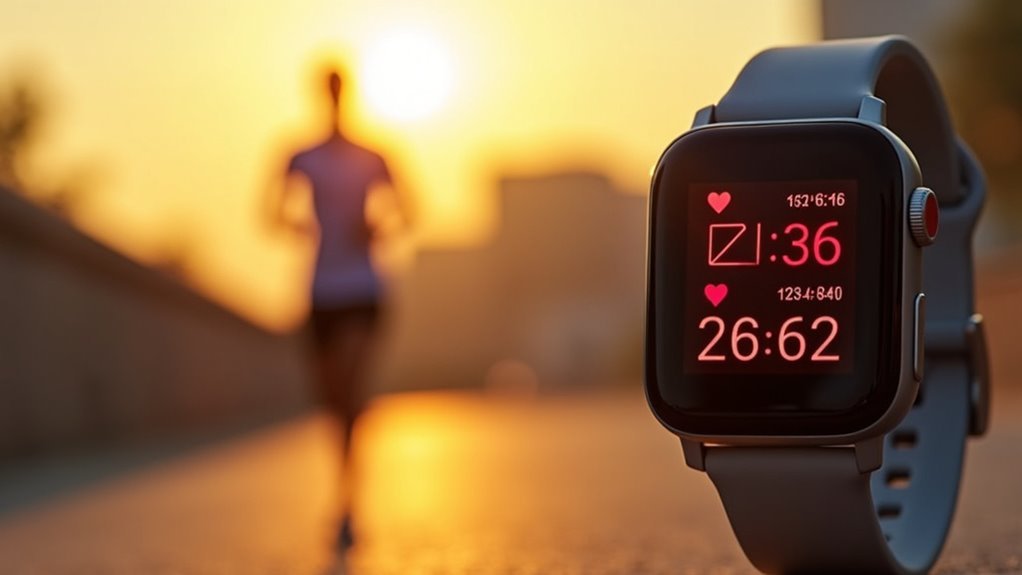
When you’re pushing through an intense workout, adaptive brightness automatically adjusts your fitness watch’s screen to match surrounding light conditions, ensuring you’ll never miss critical performance data.
This technology maintains ideal contrast and readability, whether you’re running outdoors in bright sunlight or lifting weights in a dimly lit gym.
You’ll experience reduced eye strain during prolonged sessions, allowing you to focus entirely on your performance rather than squinting at your screen.
Real-time metrics like heart rate, distance, and pace remain clearly visible, enabling you to make immediate adjustments to your workout intensity. With the new effort rating system, you can now track workout intensity on a scale from 1 to 10, providing deeper insights into your training sessions.
Stay on track with instantly visible performance data that lets you adjust your workout intensity without missing a beat.
The responsive interface lets you quickly navigate through data fields and customize your display to prioritize the metrics that matter most to your training goals.
Energy Efficiency Benefits of Smart Display Adjustments in Fitness Wearables
Smart display adjustments in fitness wearables deliver considerable energy savings by automatically reducing screen brightness in low-light environments and increasing it only when necessary for ideal visibility. You’ll notice notably extended battery life as your device optimizes power consumption based on ambient conditions.
| Feature | Traditional Display | Adaptive Display |
|---|---|---|
| Power Consumption | Constant high usage | 30-40% reduction |
| Battery Life | 1-2 days | 3-5 days |
| Energy Management | Static settings | Dynamic optimization |
Dynamic power management adapts to your activity levels, while technologies like OLED screens maintain vibrant colors without draining power. You’re getting efficient hardware that uses sampling rate adaptation during monitoring, reducing energy consumption without compromising performance. This means fewer charging interruptions during long workouts. Modern fitness watches utilize low-power technologies that further enhance battery efficiency while maintaining consistent performance throughout extended workout sessions.
Outdoor Activity Advantages: Staying Connected in Changing Light Conditions
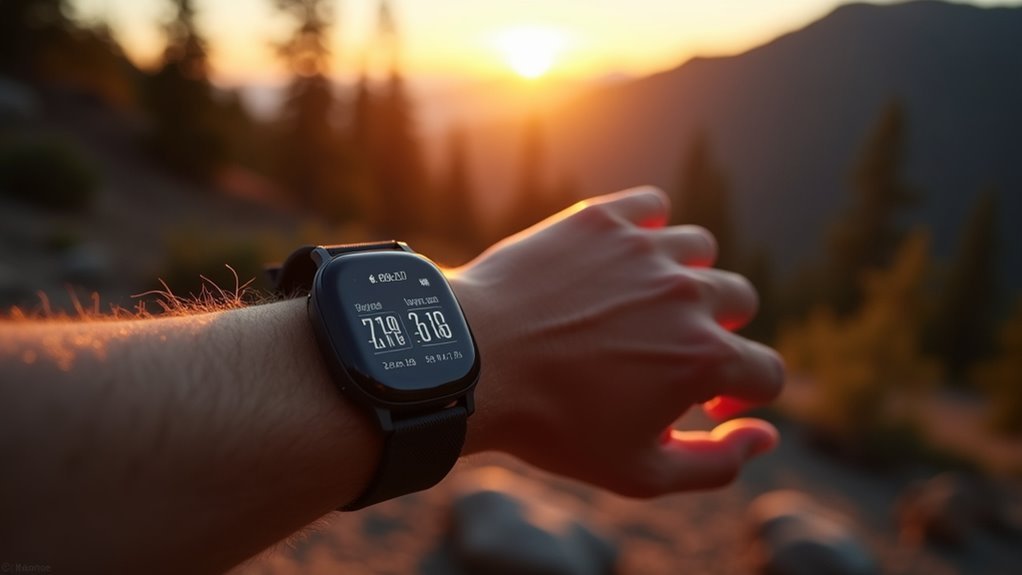
Beyond the impressive battery savings, adaptive brightness technology proves invaluable for outdoor enthusiasts who face constantly shifting light conditions.
Whether you’re hiking from shaded forests into bright clearings or running during dawn’s shift, your watch automatically adjusts its display for ideal readability. You won’t miss critical notifications about weather alerts or emergency calls because the screen adapts instantly to maintain visibility.
During tactical operations or rescue missions, adaptive brightness enhances both stealth and utility by preventing overly bright displays that compromise your position.
The technology guarantees you’ll clearly see heart rate data, GPS coordinates, and incoming messages regardless of whether you’re under blazing sunlight or maneuvering through low-light conditions. With water resistance and durability features built into modern fitness watches, you can trust your device to maintain optimal display performance even in harsh outdoor environments. This seamless adaptation eliminates the frustration of manually adjusting settings mid-activity.
User Comfort and Safety Features Through Automatic Screen Optimization
As your fitness watch automatically enhances its display throughout the day, you’ll experience considerably reduced eye strain compared to devices with fixed brightness settings. The adaptive technology adjusts screen luminance to match ambient light conditions, guaranteeing peak visibility whether you’re indoors or outdoors.
| Feature | Benefit | Impact |
|---|---|---|
| Adaptive Brightness | Reduces eye strain | Enhanced comfort |
| Auto-optimization | Improves readability | Better user interaction |
| Power management | Extends battery life | Longer usage time |
| Seamless adjustment | No manual settings needed | Increased convenience |
| Emergency visibility | Always-visible alerts | Critical safety enhancement |
You’ll find that automatic screen optimization creates a more personalized experience while supporting vital safety features like emergency alerts. This technology guarantees your fitness data remains clearly visible across various environments without compromising battery performance or your visual comfort. Optimal screen brightness also ensures accurate monitoring of your heart rate measurements, as proper visibility helps users maintain correct device positioning on their wrist.
Adaptive Vs Fixed Brightness: Why Dynamic Display Technology Wins
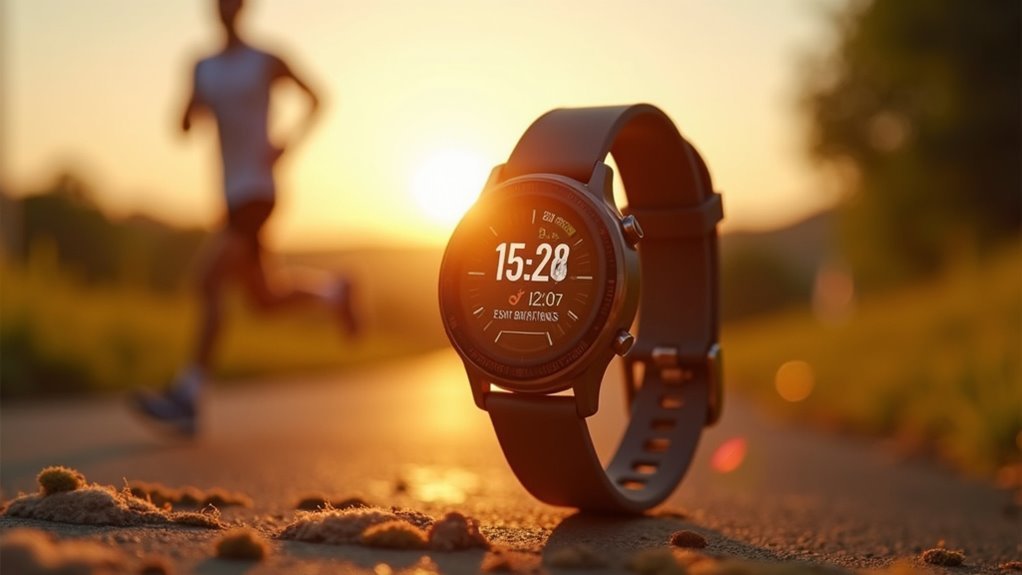
The fundamental difference between adaptive and fixed brightness systems becomes apparent when you compare their real-world performance across varying environments.
With adaptive brightness, your fitness watch automatically adjusts display intensity based on ambient light conditions, eliminating the need for manual intervention. You’ll experience ideal screen visibility whether you’re running in bright sunlight or exercising in dimly lit spaces.
Fixed brightness systems force you to constantly adjust settings manually, which proves inconvenient during workouts when your hands are occupied. This static approach also drains your battery unnecessarily, especially when maximum brightness isn’t needed.
Dynamic display technology wins because it optimizes power consumption while maintaining perfect readability, extending your device’s usage time and enhancing your overall fitness tracking experience. However, some users report auto brightness malfunctions that can make displays unreadable in dark conditions, leading to frustration and device returns.
Frequently Asked Questions
Can Adaptive Brightness Cause Eye Strain During Long Workout Sessions?
You won’t experience eye strain from adaptive brightness itself during long workouts. However, you’ll still face strain from prolonged screen viewing, blue light exposure, and individual sensitivity regardless of brightness adjustment features.
How Does Adaptive Brightness Perform in Extreme Weather Conditions Like Rain?
Adaptive brightness struggles in heavy rain as water droplets interfere with ambient light sensors, causing erratic adjustments. You’ll experience reduced screen responsiveness and visibility issues, though high water-resistant watches maintain better overall functionality.
Does Adaptive Brightness Work Properly With Polarized Sunglasses During Outdoor Activities?
Polarized sunglasses can interfere with your fitness watch’s screen visibility, but adaptive brightness usually compensates by automatically increasing brightness levels, ensuring you’ll still see metrics clearly during outdoor activities.
Can Users Manually Override Adaptive Brightness Settings When Needed During Workouts?
You can manually override adaptive brightness on most modern smartwatches, though availability varies by brand. Samsung, Huawei, and Redmi models typically allow complete disabling, while some Garmin watches offer limited manual control options.
How Quickly Does Adaptive Brightness Respond to Sudden Lighting Changes?
You’ll notice adaptive brightness responds within seconds to sudden lighting changes, though response time varies between models. High-end watches adjust faster than budget options, with sensor quality and software optimization affecting speed.
In Summary
You’ll find adaptive brightness transforms your fitness watch from a basic tracker into an intelligent workout companion. It maximizes your display visibility during intense training sessions, extends battery life for longer adventures, and keeps you safely connected whether you’re running at dawn or hiking at sunset. Don’t settle for fixed brightness settings when dynamic technology can enhance every aspect of your fitness journey.

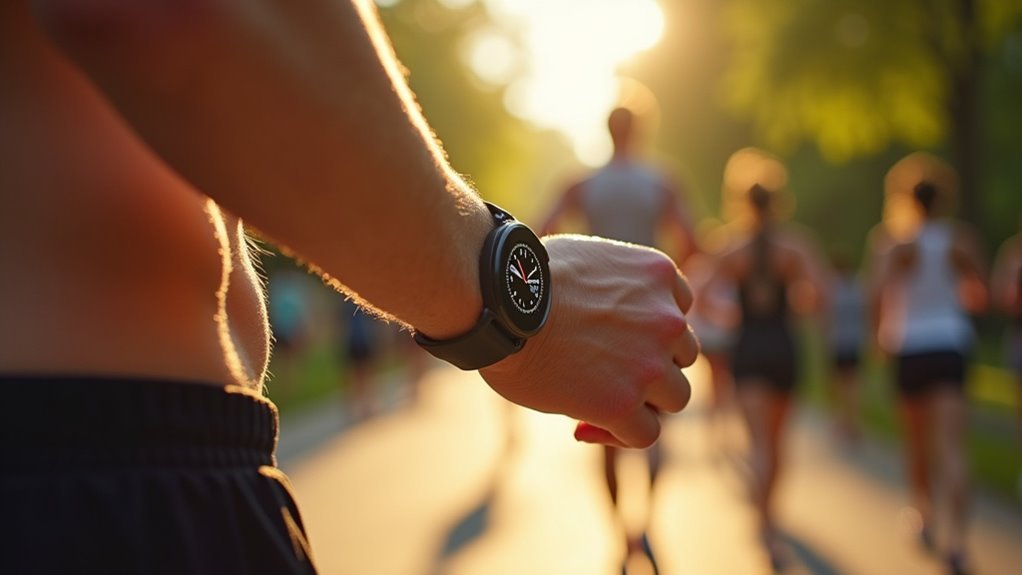
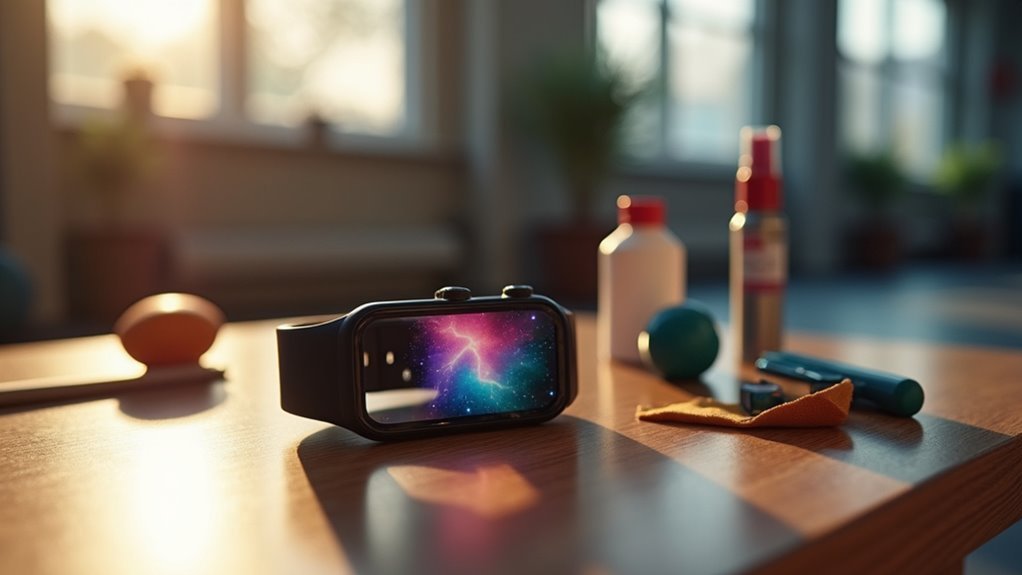

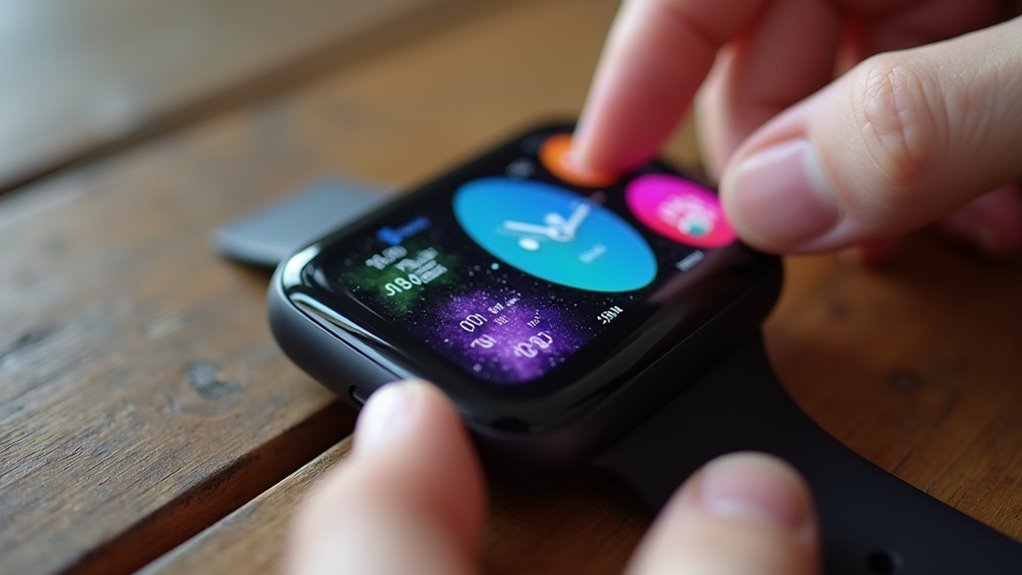
Leave a Reply